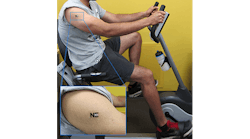Sweat equity takes on a new meaning with the development of a sensor in the form of a temporary tattoo. Postdoctoral students, including Wenzhao Jia, at the University of California at San Diego imprinted a flexible lactate sensor onto temporary tattoo paper containing an enzyme that removes electrons from lactate, producing a weak electrical current. The sensor simplifies the measurement of lactate, which is naturally present in sweat and an important indicator of how one is performing during exercise.
The tattoo sensor led the team on a quest to create a perspiration-powered biobattery. The battery’s “anode” contains the enzyme that removes electrons from lactate, and the “cathode” contains a molecule that accepts the electrons.
The new approach was announced at the 248th National Meeting & Exposition of the American Chemical Society (ACS), the world’s largest scientific society, held Aug. 12-14 in San Francisco, Calif. The sensors take the inconvenience and intrusion out of lactate testing, while microbatteries provide the convenience of recharging more quickly, using renewable sources (in this case, sweat). They’re certainly safer than traditional batteries, which can explode or leak toxic chemicals.
In testing the sensor, 10 healthy volunteers applied the tattoo to their upper arms and exercised on a stationary bike at increasing resistance levels for 30 minutes. During this time, they measured the electrical current, and continuously monitored sweat lactate levels. After receiving positive results, they took the next step to developing the biobattery.
Once the biobattery was ready for testing, 15 volunteers wore the device as they exercised on a stationary bike. People who were less fit (and exercised less than once a week) produced a greater amount of power than those who were moderately fit (and exercised one to three times per week). Those who worked out more than three times per week produced the least amount of power. The team determined that this was likely due to less-fit people becoming fatigued sooner, causing glycolysis (a producer of energy and lactate) to kick in earlier and form more lactate. In the low-fitness group, the maximum amount of energy produced was 70 µW per cm2 of skin.
The 4-µW current produced by the electrodes, which measure only 2 by 2 mm is too little to power a watch (which requires about 10 µW). However, the team is now working on enhancements to boost current to power small electronic devices. The biobattery represents the first example of epidermal electrochemical biosensing and biofuel cells, and offers serious potential for future applications.
